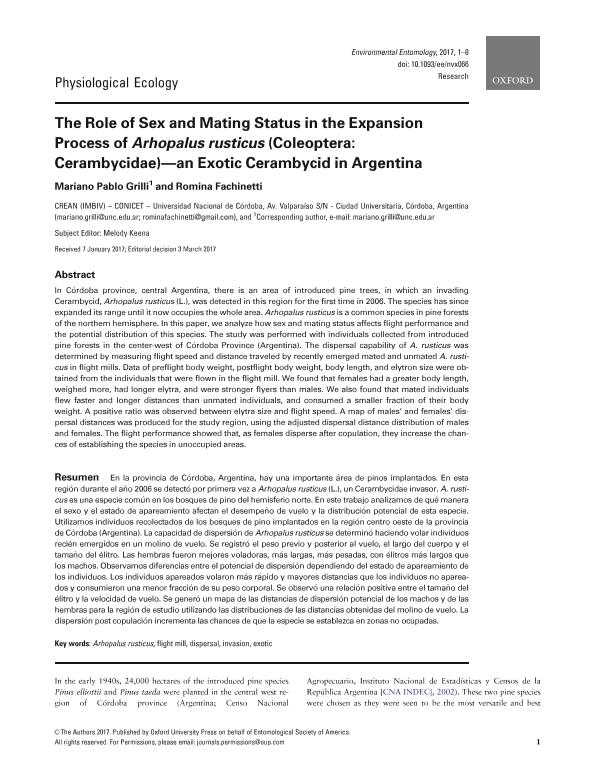Mostrar el registro sencillo del ítem
dc.contributor.author
Grilli, Mariano Pablo

dc.contributor.author
Fachinetti, Romina

dc.date.available
2019-04-24T18:28:29Z
dc.date.issued
2017-06
dc.identifier.citation
Grilli, Mariano Pablo; Fachinetti, Romina; The role of sex and mating status in the expansion process of arhopalus rusticus (coleoptera: Cerambycidae)-an exotic cerambycid in Argentina; Entomological Society of America; Environmental Entomology; 46; 3; 6-2017; 714-721
dc.identifier.issn
0046-225X
dc.identifier.uri
http://hdl.handle.net/11336/74938
dc.description.abstract
In Cordoba province, central Argentina, there is an area of introduced pine trees, in which an invading Cerambycid, Arhopalus rusticus (L.), was detected in this region for the first time in 2006. The species has since expanded its range until it now occupies the whole area. Arhopalus rusticus is a common species in pine forests of the northern hemisphere. In this paper, we analyze how sex and mating status affects flight performance and the potential distribution of this species. The study was performed with individuals collected from introduced pine forests in the center-west of Cordoba Province (Argentina). The dispersal capability of A. rusticus was determined by measuring flight speed and distance traveled by recently emerged mated and unmated A. rusticus in flight mills. Data of preflight body weight, postflight body weight, body length, and elytron size were obtained from the individuals that were flown in the flight mill. We found that females had a greater body length, weighed more, had longer elytra, and were stronger flyers than males. We also found that mated individuals flew faster and longer distances than unmated individuals, and consumed a smaller fraction of their body weight. A positive ratio was observed between elytra size and flight speed. A map of males' and females' dispersal distances was produced for the study region, using the adjusted dispersal distance distribution of males and females. The flight performance showed that, as females disperse after copulation, they increase the chances of establishing the species in unoccupied areas.
dc.format
application/pdf
dc.language.iso
eng
dc.publisher
Entomological Society of America

dc.rights
info:eu-repo/semantics/openAccess
dc.rights.uri
https://creativecommons.org/licenses/by-nc-sa/2.5/ar/
dc.subject
Arhopalus Rusticus
dc.subject
Dispersal
dc.subject
Exotic
dc.subject
Flight Mill
dc.subject
Invasion
dc.subject.classification
Otras Ciencias Agrícolas

dc.subject.classification
Otras Ciencias Agrícolas

dc.subject.classification
CIENCIAS AGRÍCOLAS

dc.title
The role of sex and mating status in the expansion process of arhopalus rusticus (coleoptera: Cerambycidae)-an exotic cerambycid in Argentina
dc.type
info:eu-repo/semantics/article
dc.type
info:ar-repo/semantics/artículo
dc.type
info:eu-repo/semantics/publishedVersion
dc.date.updated
2019-04-16T20:42:13Z
dc.identifier.eissn
1938-2936
dc.journal.volume
46
dc.journal.number
3
dc.journal.pagination
714-721
dc.journal.pais
Estados Unidos

dc.journal.ciudad
Lanham
dc.description.fil
Fil: Grilli, Mariano Pablo. Consejo Nacional de Investigaciones Científicas y Técnicas. Centro Científico Tecnológico Córdoba. Instituto Multidisciplinar de Biología Vegetal (P). Grupo Vinculado Centro de Relevamiento y Evaluación de Recursos Agrícolas y Naturales; Argentina
dc.description.fil
Fil: Fachinetti, Romina. Consejo Nacional de Investigaciones Científicas y Técnicas. Centro Científico Tecnológico Córdoba. Instituto Multidisciplinar de Biología Vegetal (P). Grupo Vinculado Centro de Relevamiento y Evaluación de Recursos Agrícolas y Naturales; Argentina
dc.journal.title
Environmental Entomology

dc.relation.alternativeid
info:eu-repo/semantics/altIdentifier/doi/http://dx.doi.org/10.1093/ee/nvx066
dc.relation.alternativeid
info:eu-repo/semantics/altIdentifier/url/https://www.ncbi.nlm.nih.gov/pubmed/28369384
Archivos asociados
